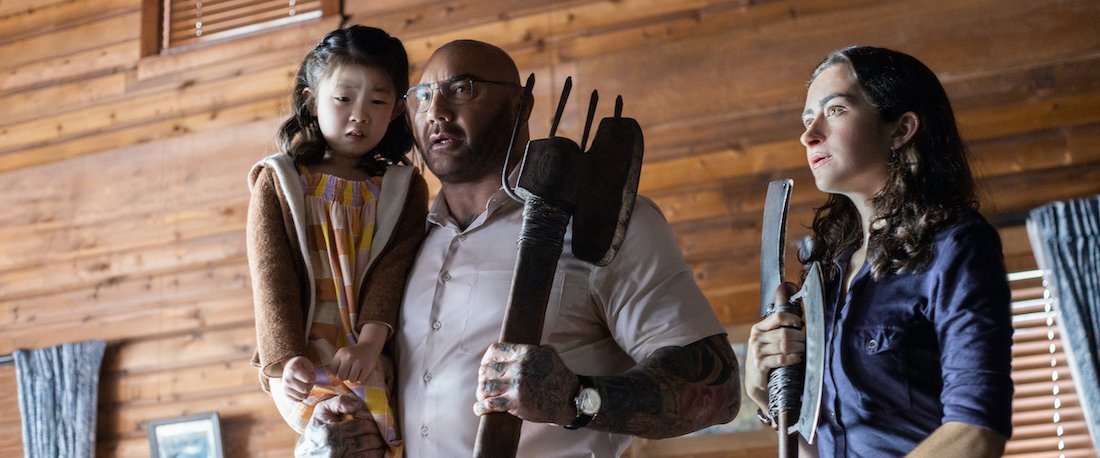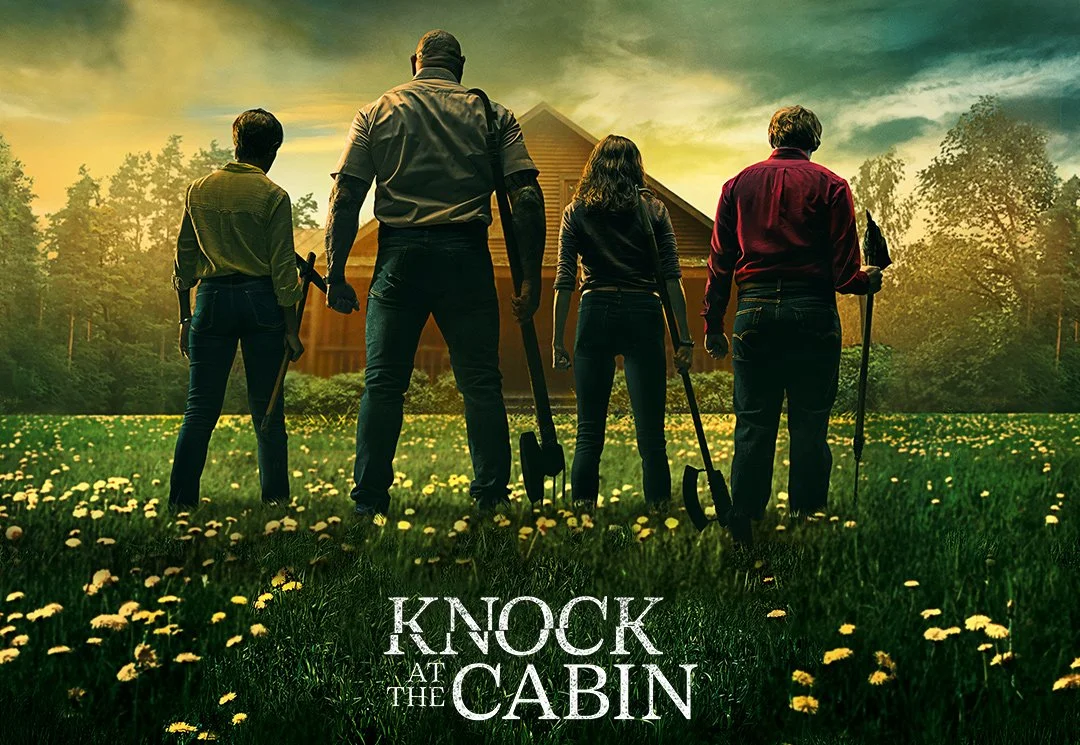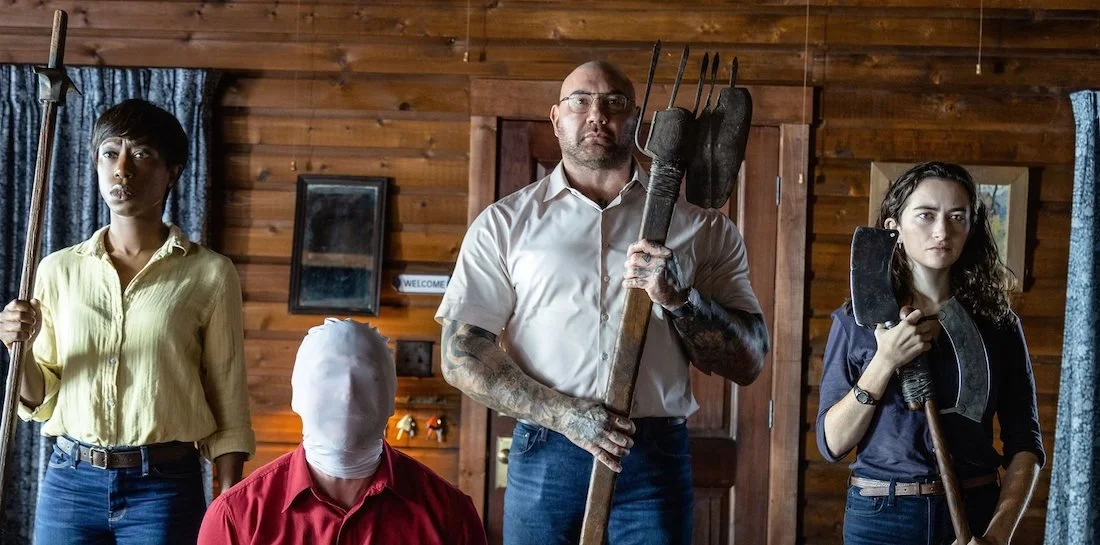Review: KNOCK AT THE CABIN
There’s an easy trap to fall into where you think “they don’t make that kind of movie anywhere.” Obviously the “they” in that sentence does a lot of heavy lifting. But when it comes to large film studios, it’s true that they have cut back on producing a whole slew of mid-range and smaller movies, weirder affairs, and even much beyond star-vehicles and tentpole blockbusters. However, those types of films still exist, you just need to look for them from different sources like indie companies, foreign countries, and some streaming offerings. Admittedly, my first impulse upon leaving KNOCK AT THE CABIN was to think that we don’t really get that many mid-tier thrillers anymore, the kind with a couple of fairly known names and without massive set pieces or action sequences. But that’s not true, they still exist albeit in those other corners I mentioned. But while there are other titles in the vein of KNOCK AT THE CABIN, it’s still nice to see major studios put out a film of its ilk that delivers an intriguing set up, strong performances, and smartly executed cinematography. It’s not a masterpiece or rise to the highs of director M. Night Shyamalan’s best work, but it is an entertaining movie in its own right.
Eric (Jonathan Groff) and Andrew (Ben Aldridge) are vacationing in a secluded cabin in the woods with their adopted daughter Web (Kristen Cui). They are surprised by a quartet of strangers, led by Leonard (Dave Bautista), who emerge from the woods and swiftly gain access to the family. Leonard and his cohorts (Rupert Grint, Nikkia Amuka-Bird, Abby Quinn) are on a mission driven by shared visions of an impending apocalypse that will soon lay waste to civilization and everyone in it. The only way to avert this calamity is for one of the family members to be sacrificed by the others, a choice that only the family themselves can make. The delusional proposition is made all the more serious by the lengths the group is willing to go to in order to convince their captives of what must be done.
For those familiar with the original novel (The Cabin At The End Of The World) by Paul Tremblay, they will be surprised not just by a different third act but also by the change in focus. Shyamalan, who co-wrote with Steve Desmond and Michael Sherman, has made this adaptation much more about the weight of sacrifice. What are people willing to give up to achieve what they believe is right? What are people willing to actively do in support of their beliefs? The book was much more concerned about questions of faith, but Shyamalan and company put the emphasis on how much this whole ordeal weighs on all the participants, the hostages as well as the hostage takers. There is never a sense of relishing anything that happens, but Shyamalan manages to make this a source of tension and not just dread. If it were so leaden, KNOCK AT THE CABIN would be a painful slog to get through. But the use of flashbacks, dialogue, and especially the performances makes this a much livelier affair than a meditation on sacrifice would seem.
Bautista shines as Leonard, the gentle giant who is incredibly reticent about his mission but is still bound by his convictions. The sense that all of this sits so heavily on his broad shoulders is perfectly conveyed in his subtle mannerisms and often hushed tones. Contrasting that is the excellent work of Groff and Aldridge who not only sell themselves as a real couple but also one under extreme duress. Their love, previous squabbles, shared history, and more all come through in their glances at each other and the shorthand they use. Cui is also strong as Wen, a child caught up in something far beyond her understanding (it’s beyond most adults’ understanding too). She’s never too precocious or twee but seems like a normal kid thrust into a highly abnormal situation with the people she loves most in the world.
Directors of Photography Jarin Blaschke and Lowell A. Meyer also help tremendously with how effective KNOCK AT THE CABIN is with its tone and pacing. Using close-ups for specific moments of isolation and doubt, careful framing that makes the quartet look apart from the world and sometimes from each other, and wide shots that take in the lush green surroundings that hide the carnage happening within (and potentially quickly approaching). Unfortunately, the sound design isn’t as stellar as it all plays pretty flat. The film would’ve benefited by created a sense of geography by having different noises, dialogue, etc. coming from different directions in the sound mix, but instead it’s too plain and uninteresting. The score by Herdís Stefánsdóttir is excellent but doesn’t do enough to offset this bland audio decision.
KNOCK AT THE CABIN could be tighter, and the tension ramped up more, especially if so much of the ending wasn’t telegraphed at certain parts. Some faster cuts in the edit and more ambiguity of what’s really happening for longer would’ve helped make this a far more engrossing and exciting film. Even with that aside, it’s still an expertly made mid-tier thriller that is probably better enjoyed on the couch than in the theater. But there are enough memorable moments and noteworthy touches that will keep viewers watching until the end, not totally certain of what it will all mean. Shyamalan and company have crafted a mostly tight, fairly original, arresting movie that feels like it would’ve been more common in other decades. While there are other examples of “this type of movie” still being made today, few of them are made as well as KNOCK AT THE CABIN.





